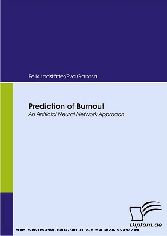Search and Find
Service
Text Sample:Possible Antecedents of Burnout:Possible causes of burnout can be classified into personality variables, work-related attitudes, and work and organizational variables. Besides above mentioned variables, Table 1.3 exhibits socio-demographic variables, even if they are no causes of burnout. However these characteristics may be linked to other factors, like gender to role taking, role expectations, or ‘feeling type’. Similarly, age is not a cause of burnout but it may be related to age-dependent factors like occupational socialization. The number of minus or plus signs in Table 1.3 on page 23 indicates the strength and the direction of the correlation with burnout, founded on three subjective criterions: (1) the number of studies that found clear evidence for the relationship, (2) the methodological quality of these studies, (3) the consistency of the results across studies.Socio-demographic variables:The most consistently to burnout connected socio-demographic variable is the age (Maslach, Schaufeli, & Leiter, 2001) Younger employees experience a higher burnout rate than those aged over 30 or 40 years or in other words, it seems that burnout takes place rather at the beginning of the career. This confirms the observation that burnout is negatively related to work experience. Some authors interpret the higher rate of burnout among the younger and less experienced persons as a reality shock. The other biographical characteristics do not show such clear relationships with burnout, although there are some studies showing that burnout takes place more frequently amongst woman than men. One explanation may be that, as a result of additional responsibilities at home, working woman experience higher overall workloads compared with working men, and workload is in turn positively related to burnout.Personality variables:It is somewhat difficult to interpret the meaning of correlations of burnout with personality features since persons interact with situations in complex ways. Even a high relationship of a particular personality characteristic does not necessarily involve causality. However, there are many studies which show that a ‘hardy personality’, characterized by participation in daily activities, a feeling of control over events, and openness to change, is consistently related to all three dimensions of the MBI. In other words, the more hardy a person is, the less burned-out he or she will be (Maslach et al., 2001). Another strong related personal characteristic is neuroticism, which includes trait anxiety, hostility, depression, self-consciousness and vulnerability. A neurotic person is emotionally unstable and she or he seems to be predisposed to experience burnout (Schaufeli & Enzmann, 1998).A person’s control orientation may either be external or internal. Individuals with an external control orientation attribute events and achievements to powerful others or to chance, whereas those with an internal control orientation ascribe events and achievements to their own effort, ability, and willingness to risk. External control orientated persons are, compared with internal control orientated persons, more emotionally exhausted, depersonalized, and experience feelings of personal accomplishment (Glass & McKnight, 1996).Another interesting and important relationship was found between a person’s coping style and burnout. Those individuals who are burned out cope with stressful events in a rather passive, defensive way, whereas an active and confronting coping style is used by less burned out persons. Work and organizational variables:Workload and time pressure are highly related to emotional exhaustion but, and this is striking, practically unrelated to personal accomplishment. Role stress, role conflict, and role ambiguity correlate fairly to substantially with burnout. Role theory (e.g., Jackson & Schuler, 1985, Katz & Kahn, 1978) suggests that inter-role conflict and tension often results in individuals who find it increasingly difficult to successfully execute each of their roles because of constrained resources (e.g., energy, time) or the incompatibility among different roles (e.g., employee roles vs. family roles). Specifically, role stress emerges from the impact of the environment on an individual’s ability to fulfill role expectations (Beehr & Glazer, 2005). During the past decades, the number of (especially female) individuals having two or more jobs (due to economical reasons) has increased steadily. In the light of role theory, this development which implicates role stress since these individuals have to fulfill two or, when the family role is included three roles, is associated with negative consequences for the individuals and the organizations.
All prices incl. VAT













